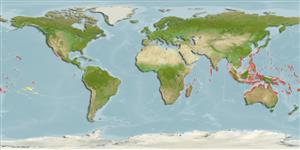Common names from other countries
>
Blenniiformes (Blennies) >
Blenniidae (Combtooth blennies) > Salariinae
Etymology: Istiblennius: Greek, istios = sail + Greek, blennios = mucus (Ref. 45335).
More on author: Günther.
Environment: milieu / climate zone / depth range / distribution range
Ecología
marino asociado a arrecife; rango de profundidad 0 - 3 m (Ref. 30874). Tropical
Western Indian Ocean: 3 mi north of Muqadisho, Somalia, south to Bolito Bay, Natal, South Africa; St. Pierrw (Seychelles); Nossi Be, Madagascar, Juan de Nova Island; Mauritius. Eastern Indian Ocean: Christmas Island. Pacific Ocean: New Hebrides, Niuafo'ou, Samoa, Niue, Marquesas, Saipan Islands.
Tamaño / Peso / Age
Maturity: Lm ? range ? - ? cm
Max length : 16.0 cm SL macho / no sexado; (Ref. 4404); 13.1 cm SL (female)
Short description
Morfología | Morfometría
Espinas dorsales (total): 12 - 14; Radios blandos dorsales (total): 20-22; Espinas anales 2; Radios blandos anales: 20 - 22. Body of males with several paired bands; spots from mouth to nape and posterior part of body; dusky stripes on segmented portion of dorsal fin (Ref. 4404). Females with dusky bands on body; head, body and fins (except pelvic fins) covered with fine dark specs (Ref. 4404).
Facultative air-breathing (Ref. 126274); Adults are found in intertidal flats and rock shores (Ref. 90102). Oviparous. Eggs are demersal and adhesive (Ref. 205), and are attached to the substrate via a filamentous, adhesive pad or pedestal (Ref. 94114). Larvae are planktonic, often found in shallow, coastal waters (Ref. 94114).
Life cycle and mating behavior
Madurez | Reproducción | Puesta | Huevos | Fecundidad | Larva
Oviparous, distinct pairing (Ref. 205).
Springer, V.G. and J.T. Williams, 1994. The Indo-West Pacific blenniid fish genus Istiblennius reappraised: a revision of Istiblennius, Blenniella, and Paralticus, new genus. Smithson. Contrib. Zool. 565:1-193. (Ref. 9962)
IUCN Red List Status (Ref. 130435)
CITES (Ref. 128078)
Not Evaluated
Threat to humans
Harmless
Human uses
Más información
ReferenciasAcuiculturaPerfil de acuiculturaRazasGenéticaElectrophoresesheritabilidadEnfermedadesProcesamientoMass conversion
Herramientas
Special reports
Download XML
Fuentes de Internet
Estimates based on models
Preferred temperature (Ref.
115969): 24.8 - 29.3, mean 28.3 (based on 2052 cells).
Phylogenetic diversity index (Ref.
82804): PD
50 = 0.5001 [Uniqueness, from 0.5 = low to 2.0 = high].
Bayesian length-weight: a=0.01072 (0.00480 - 0.02393), b=3.01 (2.82 - 3.20), in cm Total Length, based on LWR estimates for this (Sub)family-body shape (Ref.
93245).
Nivel trófico (Ref.
69278): 2.0 ±0.00 se; based on food items.
Resiliencia (Ref.
120179): Medio, población duplicada en un tiempo mínimo de 1.4-4.4 años (Preliminary K or Fecundity.).
Fishing Vulnerability (Ref.
59153): Low vulnerability (10 of 100).
